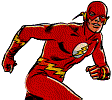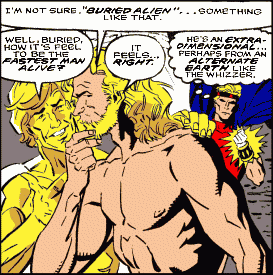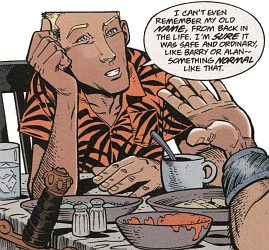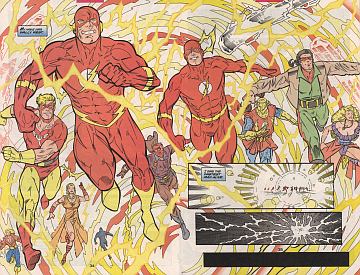See Also: The Lost Days of Barry Allen

Barry Allen, the Silver Age Flash, has been called “DC’s first official saint.” He died saving the entire universe, after all, and to avoid cheapening that sacrifice he is likely to be one of the few comic book characters whose death will actually stick.
However, his virtual sainthood has led to Barry being sighted as often as Elvis, because there’s some disagreement as to just what happened when he died. In Crisis on Infinite Earths #8 it was clear that he was traveling backward through time as he ran to his death. But just what happened to him—aside from him dying, of course—was unclear.
The Human Thunderbolt

According to Secret Origins Annual 2 (1988), Barry was transformed into electricity as he went back into time, eventually becoming the lightning bolt that hit his lab, splashing his past self with charged chemicals and transforming him into the Flash.
Sometimes life is sweet. My name was Barry Allen, and all that I ever wanted was to be the fastest man alive. A human thunderbolt. As a scientist I should have realized right from the start that electricity always travels in a circuit...and lightning can strike twice in the same place. Oh, boy...can it ever.
Reborn to Run

Marvel Comics got into the act in 1990, with Quasar #17, in which a blond amnesiac in the tatters of a red outfit appears in the middle of a super-speed race and outruns all the contestants. Asked his same, he replied. “I’m not sure. Buried Alien...something like that.” The race’s host replied, “Well, Buried, how’s it feel to be the fastest man alive?”
A few years later, a follow-up story appeared in Quasar #58. By this time “Buried Alien” had taken the name Fastforward and decided to make the most of his life, even though he knows he’s in a universe not his own.
See Quasar: Reborn to Run for more detail.
The Speed Force
The Terminal Velocity storyline (Flash #95–100, 1994–1995) established the idea of the Speed Force as a “Valhalla for speedsters”—it was strongly implied that Barry had joined with the source of his power and the spirits of speedsters from throughout the ages. This was followed up on in Flash Annual #11 (1998), in which Johnny Quick is able to return and say goodbye to his daughter (and mentions he’s spoken to Barry), and later in Flash #150 (1999), which shows Barry, Wally, Johnny Quick, and many other speedsters as part of the Speed Force. Finally, Impulse #82 showed Max Mercury communing with the spirits of the Speed Force...including Johnny Quick and Barry.
The story of Barry merging with the Speed Force is told in JLA Incarnations #5 (2001), an issue devoted to the Justice League’s part in the Crisis on Infinite Earths.
Fast enough? Not yet. Light calling to me...drawing me forward...what is it? I hear it in my heart. The essence of what I am. The source and the end. Speed itself. It reminds me. What I stand for. What the League stands for. My life doesn’t matter. I can save them. If I just let go...and then I am in it and I am a part of it and I am everywhere. I am the lightning and I am reaching out and there are no accidents!
Marv Wolfman revisited Barry’s death in the novelization of Crisis on Infinite Earths (2005), which was told from Barry’s point of view—during his final run. As he joined with the Speed Force, the spirits of past speedsters sent him back to assist the Monitor in his scheme to save just a few universes out of the many threatened. The unseen Flash, it turns out, tipped the balance in a number of critical events—preserving the last few Earths, for instance, and killing the Anti-Monitor—before meeting his ultimate fate.
Heaven

Green Arrow #7 & 8 (2001) deal with Oliver Queen visiting Heaven, where he finds not only Hal Jordan, but Barry Allen. In fact, it suggests that Barry’s never actually encountered the Speed Force. At one point he remarks that Wally has “tapped into what he calls speed force, darndest thing...”
The Dead Legends Café

In The Sandman Presents: The Thessaliad #3 (2002), the witch Thessaly and her companion take a pause from her mystical quest and catch lunch at the Living Dead Legends Café. Two tables over a man with blond hair in a crew-cut is talking with a hero from medieval Ireland. “I’m just not sure who I am anymore,” he says. “Not since I died. I can’t even remember my old name, from back in the life. I’m sure it was safe and ordinary, like Barry or Alan—something normal like that.”
So Where Is He?
The general rule on comic book contradictions is that a character’s “home” series takes precedence. So if The Flash states one thing about Barry and JLA states another, the version in The Flash is more “official.”
So by this rule, Barry is part of the Speed Force, and the others are inaccurate. Whether Kevin Smith (Green Arrow) and Bill Willingham (The Thessaliad) didn’t research or deliberately ignored Barry’s fate, neither fits established continuity. (The Quasar story predates the Speed Force, and doesn’t affect things anyway since it was put out by another publishing company.)
But can they be combined? After all, the other stories do have consequences of their own, and if just erasing Barry’s part has no impact on The Thessaliad, it does impact Green Arrow.
It’s been implied that time works differently within the Speed Force. JLA Incarnations #5 showed Barry gaining knowledge of the future and seeing Flashes spanning the next thousand years. We know the Speed Force had a hand in giving Barry his powers. Then there’s the line, “And there are no accidents.” So the Human Thunderbolt can be tied in with the Speed Force: he became part of the Speed Force, which struck his past self in the form of a lightning bolt.
As for the afterlife, it’s been suggested that the Speed Force actually overlaps with Heaven, and it’s all a matter of perspective. Just as different people may perceive Death as the Grim Reaper, the Black Flash, or the Black Racer, they could perceive the afterlife differently. Green Arrow would see Barry in Heaven, Max would see him in the Speed Force, Thessaly would see him in a modernized Valhalla, etc. Yet each “Barry” seems to have no knowledge of the other afterlives.
Another explanation is Hypertime, which was invented in part to explain the inevitable continuity glitches that arise when trying to coordinate myriad writers and artists working with hundreds of characters and sixty years of history, much of which has been wiped out or rewritten. Each story would take place on a slightly different timeline, but because timelines can merge, the consequences could still affect the mainstream DCU.
I prefer (and this is just my opinion) to think of the various Barry appearances as echoes or shadows of the hero. As seen in Flash and Impulse, he’s really in the Speed Force, but his legend has had such impact that others see him where they might expect to: in Heaven, or in the company of dead heroes, or in a cosmic race to find the Fastest Man Alive.
Text by Kelson Vibber. Do not copy without permission. Primary Sources
Primary Sources
- “A Flash of the Lightning!” - Crisis on Infinite Earths #8 (November 1985), Marv Wolfman
- “Mystery of the Human Thunderbolt,” - Secret Origins Annual 2 (1988), Robert Loren Fleming
- “Reborn to Run” - Quasar #17 (December 1990), Mark Gruenwald
- “Distant Running” - Quasar #58 (May 1994), Mark Gruenwald
- “Haunts” - Flash Annual #11 (1998), Brian Augustyn
- “Double Visions” - Impulse #82 (March 2002), Todd Dezago
- “Changes” - JLA Incarnations #5 (November 2001), John Ostrander
- “Quiver Chapter 7: Hard Traveling Heroes” - Green Arrow #7 (October 2001), Kevin Smith
- “Necromancer or What Ever Made You Think Ghosts Carry Money?” - The Sandman Presents: The Thessaliad #3 (May 2002), Bill Willingham
- Crisis on Infinite Earths (novel, 2005), Marv Wolfman
Art
- The Flash: Showcase #4 (September–October 1956) - Carmine Infantino and Joe Kubert
- The Human Thunderbolt: Secret Origins Annual 2 (1988) - Carmine Infantino and Murphy Anderson
- Reborn to Run: Quasar #17 (December 1990) - Mike Manley
- The Speed Force: The Flash (second series) #150 (July 1999) - Paul Pelletier and Vince Russell
- Trio in Heaven: Green Arrow #7 (October 2001) - Phil Hester and Ande Parks
- The Dead Legends Café: The Sandman Presents: The Thessaliad #3 (May 2002) - Shawn McManus & Andrew Pepoy
